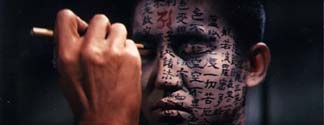

Japan suspense
1964
color 164 min.
Director: Masaki Kobayashi
CLV: $59.95 - available
2 discs, catalog # CC1237L
VHS: available from Home Vision Cinema

One
of the most meticulously crafted supernatural fantasy films ever made, Masaki
Kobayashi's Kwaidan (1964) is also one of the most unusual. While such
classic black and white chillers as The Uninvited, The Innocents
and The Haunting teasingly speculate on the existence of ghosts, this
lavish widescreen and color production deals with the spirit world head-on, as
something completely and frighteningly real.Consisting of four episodes,
Kwaidan is based on the writings of Lafcadio Hearn, a folklorist of
Greek-Irish ancestry who came to the United States in 1869 and later moved to
Japan. Hearn became a naturalized Japanese citizen in 1895, and changed his name
to Yakumo Koizumi. If total assimilation of his adopted culture was Hearn's goal,
then he clearly achieved it, for it's impossible to tell that Kwaidan's
source material is in any way western. As directed by Kobayashi, Hearn's four
tales unfurl across the screen like versions of the classic Japanese paintings of
the historical periods in which the film is set.
Winner of the Special Jury
Prize at the 1965 Cannes Film Festival, Kwaidan represents a considerable
departure from the works of its director, who made his initial fame with such
socially conscious dramas as Black River (a study of corruption brought
about by U.S. military bases in Japan) and The Human Condition (an expose
of Japanese mistreatment of Chinese in P.O.W. camps). Shot almost entirely in
enormous studio sets, with a completely post-synched and carefully controlled
soundtrack, Kwaidan is about as far from moviemaking "realism" as it's
possible to go. Yet in going to such dramatically ambitious lengths as adapting
aspects of Kabuki and Bunraku puppet theatre to filmmaking techniques, Kobayashi
achieves a subtle synthesis of realism and stylization. He makes palpable a
vision in which beauty and horror not only coexist but complement one
another.
The first episode, "The Black Hair," tells of a poor samurai (Rentaro
Mikuni) who divorces his patient, loving wife (Michiyo Aratama) when he gets a
chance to marry a rich man's daughter (Misako Watanabe). But the samurai quickly
discovers that wealth and security mean nothing next to true love. Longing for
his first wife, he returns to her. Happily, while his old house may be a bit
dilapidated, his first wife hasn't changed a bit since he left her. Her beautiful
black hair is as lustrous as ever. Thrilled by this curious sight, he vows to
stay with her for all eternity. But what's really behind her seemingly unaltered
state? And what would an "eternity" with her really mean?
Thwarted love appears
in a different guise in the film's second episode, "The Woman of the Snow." Set
in a forbidding frozen forest, it tells of a poor woodcutter (Tatsuya Nakadai)
lost in a snowstorm with a friend (Jun Hamamura). Taking refuge in a shack, the
pair collapse from exhaustion. But when the woodcutter awakens, he discovers a
mysterious ghost-like woman (Keiko Kishi) blowing her icy breath over his
friend's body and killing him. Spotting the woodcutter, the deadly phantom takes
pity on him and spares his life. But in doing so, the woman warns him that he
must never repeat, to anyone, what he has seen.
Ten years pass. The woodcutter
is a happily married man with three children. His wife, praised by the community
as an ideal of patience and beauty, doesn't (like the heroine of our first
episode) appear to age. Yet, so secure is our hero in his family that he's
prepared to tell his wife about the mysterious woman who nearly brought his life
to an end. But is this wife truly who she seems to be? Is she somehow connected
with the icy succubus whose path he crossed years before?
In the film's third
(and most grisly) episode, "Hoichi, the Earless," the supernatural appears in a
strikingly different form. Set in a monastery, the story centers on a blind
musician (Kazuo Nakamura) who delights in singing songs of the ancient sea battle
between the Heike and Genji clans whose burial grounds are within walking
distance of the monastery. In fact, so touching is Hoichi's singing that the
ghosts rise up and demand the blind man give a command performance for them.
Hoichi is willing to do so, but his late-night performances before this ghostly
audience put a strain on his health that catches the attention of the monastery's
head monk (Takashi Shimura). Telling Hoichi that the ghosts will rip him to
pieces if he continues to sing for them, the monk takes precautions by painting
the singer's entire body with prayer verses to ward off spirits. Unfortunately,
he fails to paint Hoichi's ears.
The film's last episode, "In a Cup of Tea,"
brings the story cycle to a close with a tale about storytelling in which a
writer recounts the saga of a warrior (Kan-Emon Nakamura) who discovers the
reflection of someone else while glancing into his cup of tea. Soon the warrior
is confronted by this interloper in the flesh. But in challenging him to a duel,
our hero learns that he's dealing with a very elusive phantom. Soon this teasing
spirit is joined by a trio of others that the warrior fights off with similarly
frustrating results. How will it all end?
As the film shows in its chilling,
Borges-like finale, this is achieved through the very process of storytelling
itself. It makes a fitting, witty conclusion to a film that -- with beauty,
subtlety and shock -- draws the viewer further from the real world, and closer
and closer to the supernatural.
-- DAVID
EHRENSTEIN
Credits
Director: Masaki Kobayashi
Producer: Shigeru
Wakatsuki
Screenplay: Yoko Mizuki
Original Story by: Lafcadio
Hearn
Cinematographer: Yoshio Miyajima
Art Director: Shigemasa
Toda
Music: Tohru Takemitsu
Sound: Hideo Nishizaka
Lighting: Akira
Aomatsu
Editor: Hisashi Sagara
Transfer
This edition of
Kwaidan was transferred from a 35mm master print in its correct widescreen
aspect ratio.





